Revealing the Ground Deformation and Its Mechanism in the Heihe River Basin by Interferometric Synthetic Aperture Radar and Optical Images
Abstract
1. Introduction
2. Study Area and Datasets
2.1. Study Area
2.2. Datasets
2.2.1. InSAR Data
2.2.2. Optical Remote Sensing Data
- (1)
- Land cover data
- (2)
- NDVI data
- (3)
- Soil moisture data
- (4)
- Precipitation data
- (5)
- Soil type data
3. Methodology and Data Processing
3.1. InSAR Data Processing
3.1.1. Monitoring the Ground Deformation Time Series
3.1.2. Wide-Area InSAR Results Splicing
3.2. Optical Remote Sensing Data Processing
3.3. Correlation Analysis of O-RS and InSAR Deformation
4. Results
4.1. Surface Deformation in HRB
4.2. O-RS Results
4.3. Reliability Validation
- (1)
- InSAR
- (2)
- Optical remote sensing
5. Discussion
5.1. Factors Affecting the Development of Deformation at Spatial Dimensions in HRB
5.2. Factors Affecting the Development of Deformation at Time Dimension in HRB
5.3. The Importance of Integrated Remote Sensing for Inland River Basin Monitoring
6. Conclusions
Author Contributions
Funding
Institutional Review Board Statement
Informed Consent Statement
Data Availability Statement
Acknowledgments
Conflicts of Interest
References
- Che, T.; Li, X.; Liu, S.; Li, H.; Xu, Z.; Tan, J.; Zhang, Y.; Ren, Z.; Xiao, L.; Deng, J.; et al. Integrated hydrometeorological, snow and frozen-ground observations in the alpine region of the Heihe River Basin, China. Earth Syst. Sci. Data 2019, 11, 1483–1499. [Google Scholar] [CrossRef]
- Du, E.; Tian, Y.; Cai, X.; Zheng, Y.; Li, X.; Zheng, C. Exploring spatial heterogeneity and temporal dynamics of human-hydrological interactions in large river basins with intensive agriculture: A tightly coupled, fully integrated modeling approach. J. Hydrol. 2020, 591, 125313. [Google Scholar] [CrossRef]
- Han, F.; Zheng, Y.; Tian, Y.; Li, X.; Zheng, C.; Li, X. Accounting for field-scale heterogeneity in the ecohydrological modeling of large arid river basins: Strategies and relevance. J. Hydrol. 2021, 595, 126045. [Google Scholar] [CrossRef]
- Kang, J.; Jin, R.; Li, X.; Zhang, Y. Mapping High Spatiotemporal-Resolution Soil Moisture by Upscaling Sparse Ground-Based Observations Using a Bayesian Linear Regression Method for Comparison with Microwave Remotely Sensed Soil Moisture Products. Remote Sens. 2021, 13, 228. [Google Scholar] [CrossRef]
- Li, X.; Cheng, G.; Ge, Y.; Li, H.; Han, F.; Hu, X.; Tian, W.; Tian, Y.; Pan, X.; Nian, Y.; et al. Hydrological Cycle in the Heihe River Basin and Its Implication for Water Resource Management in Endorheic Basins. J. Geophys. Res. Atmos. 2018, 123, 890–914. [Google Scholar] [CrossRef]
- Ruehr, S.; Lee, X.; Smith, R.; Li, X.; Xu, Z.; Liu, S.; Yang, X.; Zhou, Y. A mechanistic investigation of the oasis effect in the Zhangye cropland in semiarid western China. J. Arid Environ. 2020, 176, 104120. [Google Scholar] [CrossRef]
- Wang, H.; Li, X.; Xiao, J.; Ma, M.; Tan, J.; Wang, X.; Geng, L. Carbon fluxes across alpine, oasis, and desert ecosystems in northwestern China: The importance of water availability. Sci Total Env. 2019, 697, 133978. [Google Scholar] [CrossRef]
- Feng, G.; Li, Z. Terrain and Deformation Monitoring in the Pearl River Delta Based on Radar Interferometry; School of Geosciencces and Info-Physic, Central South School: Changsha, China, 2019; p. 224. [Google Scholar]
- Massonnet, D.; Rossi, M.; Carmona, C.; Adragna, F.; Peltzer, G.; Feigl, K.; Rabaute, T. The displacement field of the landers earthquake mapped by radar interferometry. Nature 1993, 364, 138–142. [Google Scholar] [CrossRef]
- Wang, H.; Feng, G.; Miao, L.; Tan, J.; Xiong, Z. The characteristics and evolution of surface deformation induced by agricultural irrigation in the Junggar Basin from the perspective of InSAR. J. Remote Sens. 2020, 24, 1233–1242. [Google Scholar] [CrossRef]
- Xu, W.; Xie, L.; Aoki, Y.; Rivalta, E.; Jonsson, S. Volcano-Wide Deformation After the 2017 Erta Ale Dike Intrusion, Ethiopia, Observed With Radar Interferometry. J. Geophys. Res.-Solid Earth 2020, 125, e2020JB019562. [Google Scholar] [CrossRef]
- Zhang, Y.; Wu, H.; Kang, Y. Ground Subsidence over Beijing-Tianjin-Hebei Region during Three Periods of 1992 to 2014 Monitored by Interferometric SAR. Acta Geod. Cartogr. Sin. 2016, 45, 1050–1058. [Google Scholar]
- Zhu, J.; Yang, Z.; Li, Z. Recent progress in retrieving and predicting mining-induced 3D displace-ments using InSAR. Acta Geod. Et Cartogr. Sin. 2019, 48, 135–144. [Google Scholar] [CrossRef]
- Zhang, Q.; Kang, S.; Wang, J. Elevation change of the Laohugou Glacier No. 12 in the western Qilian Mountains from 2000 to 2014. J. Glaciol. Geocryol. 2017, 39, 733–740. [Google Scholar]
- Chen, J.; Liu, L.; Zhang, T.; Cao, B.; Lin, H. Using Persistent Scatterer Interferometry to Map and Quantify Permafrost Thaw Subsidence: A Case Study of Eboling Mountain on the Qinghai-Tibet Plateau. J. Geophys. Res.-Earth Surf. 2018, 123, 2663–2676. [Google Scholar] [CrossRef]
- Chen, Y.; Jiang, L.; Liang, L.; Zhou, Z. Monitoring permafrost deformation in the upstream Heihe River, Qilian Mountain by using multi-temporal Sentinel-1 InSAR dataset. Chin. J. Geophys. 2019, 62, 2441–2454. [Google Scholar]
- Peng, S.; Peng, X.; Frauenfeld, O.W.W.; Yang, G.; Tian, W.; Tian, J.; Ma, J. Using InSAR for Surface Deformation Monitoring and Active Layer Thickness Retrieval in the Heihe River Basin on the Northeast Qinghai-Tibet Plateau. J. Geophys. Res.-Earth Surf. 2023, 128, e2022JF006782. [Google Scholar] [CrossRef]
- Yang, W.; He, Y.; Zhang, L.; Wang, W.; Chen, Y.; Yi, C. InSAR monitoring of 3D surface deformation in Jinchuan mining area, Gansu Province. Remote Sens. Nat. Resour. 2022, 34, 177–188. [Google Scholar]
- Yang, S.; Xue, Z.; Zhang, L.; Su, H.; Zhou, S. Fusion of hyperspectral and LiDAR data: A case study for refined crop classification in agricultural region of Zhangye Oasis in the middle reaches of Heihe River. Remote Sens. Land Resour. 2018, 30, 33–40. [Google Scholar]
- Zhong, W. Investigation on Deformation of Thermokarst Terrain in Permafrost Regions over Heihe River Basin in Qilian Mountains. Master’s Thesis, Lanzhou University, Lanzhou, China, 2019. [Google Scholar]
- Liang, L.; Jiang, L.; Zhou, Z.; Chen, Y.; Sun, Y. Object—Oriented classification of unmanned aerial vehicle image for thermal erosion gully boundary extraction. Remote Sens. Land Resour. 2019, 31, 180–186. [Google Scholar]
- Qiao, X.; Liu, P.; Ren, Y.; Si, W.; Hua, Y. Analysis of the characteristics and driving factors of ecological environment changes in Heihe river basin based on remote sensing data. China Environ. Sci. 2020, 40, 3962–3971. [Google Scholar]
- Wang, H.; Li, X.; Xiao, J.; Ma, M. Evapotranspiration components and water use efficiency from desert to alpine ecosystems in drylands. Agric. For. Meteorol. 2021, 298–299, 108283. [Google Scholar] [CrossRef]
- Li, X.; Gou, X.; Wang, N.; Sheng, Y.; Jin, H.; Qi, Y.; Song, X.; Hou, F.; Li, Y.; Zhao, C.; et al. Tightening ecological management facilitates green development in the Qilian Mountains. Chin. Sci. Bull. 2019, 64, 2928–2937. [Google Scholar]
- Ge, Y.; Li, X.; Tian, W.; Zhang, Y.; Wang, W.; Hu, X. The Impacts of Water Delivery on Artificial Hydrological Circulation System of the Middle Reaches of the Heihe River Basin. Adv. Earth Sci. 2014, 29, 285–294. [Google Scholar]
- Karra, K.; Kontgis, C.; Statman-Weil, Z.; Mazzariello, J.C.; Mathis, M.; Brumby, S.P. Global land use/land cover with Sentinel 2 and deep learning. In Proceedings of the 2021 IEEE International Geoscience and Remote Sensing Symposium IGARSS, Virtual, 11–16 July 2021; pp. 4704–4707. [Google Scholar]
- Didan, K. MOD13Q1 MODIS/Terra vegetation indices 16-day L3 global 250m SIN grid V006. NASA Eosdis Land Process. Daac 2015, 10. [Google Scholar]
- Li, Q.; Shi, G.; Shangguan, W.; Nourani, V.; Li, J.; Li, L.; Huang, F.; Zhang, Y.; Wang, C.; Wang, D.; et al. A 1 km daily soil moisture dataset over China using in situ measurement and machine learning. Earth Syst. Sci. Data 2022, 14, 5267–5286. [Google Scholar] [CrossRef]
- Shangguan, W.; Li, Q.; Shi, G. China Soil Moisture Dataset (2000–2020); A Big Earth Data Platform for Three Poles: Lanzhou, China, 2022. [Google Scholar] [CrossRef]
- Peng, S.; Ding, Y.; Wen, Z.; Chen, Y.; Cao, Y.; Ren, J. Spatiotemporal change and trend analysis of potential evapotranspiration over the Loess Plateau of China during 2011–2100. Agric. For. Meteorol. 2017, 233, 183–194. [Google Scholar] [CrossRef]
- Peng, S. 1-Km Monthly Precipitation Dataset for China (1901–2021); A Big Earth Data Platform for Three Poles: Lanzhou, China, 2020. [Google Scholar] [CrossRef]
- Shi, X.Z.; Yu, D.S.; Yang, G.X.; Wang, H.J.; Sun, W.X.; Du, G.H.; Gong, Z.T. Cross-reference benchmarks for translating the Genetic Soil Classification of China into the Chinese Soil Taxonomy. Pedosphere 2006, 16, 147–153. [Google Scholar] [CrossRef]
- Berardino, P.; Fornaro, G.; Lanari, R.; Sansosti, E. A new algorithm for surface deformation monitoring based on small baseline differential SAR interferograms. IEEE Trans. Geosci. Remote Sens. 2002, 40, 2375–2383. [Google Scholar] [CrossRef]
- Farr, T.G.; Rosen, P.A.; Caro, E.; Crippen, R.; Duren, R.; Hensley, S.; Kobrick, M.; Paller, M.; Rodriguez, E.; Roth, L. The shuttle radar topography mission. Rev. Geophys. 2007, 45, RG2004. [Google Scholar] [CrossRef]
- Werner, C.; Wegmüller, U.; Strozzi, T.; Wiesmann, A. Gamma SAR and interferometric processing software. In Proceedings of the Ers-Envisat Symposium, Gothenburg, Sweden, 16–20 October 2000; p. 1620. [Google Scholar]
- Wang, Y.; Feng, G.; Li, Z.; Xu, W.; Zhu, J.; He, L.; Xiong, Z.; Qiao, X. Retrieving the displacements of the Hutubi (China) underground gas storage during 2003–2020 from multi-track InSAR. Remote Sens. Environ. 2022, 268, 112768. [Google Scholar] [CrossRef]
- Xiong, Z.; Feng, G.; Feng, Z.; Miao, L.; Wang, Y.; Yang, D.; Luo, S. Pre- and post-failure spatial-temporal deformation pattern of the Baige landslide retrieved from multiple radar and optical satellite images. Eng. Geol. 2020, 279, 105880. [Google Scholar] [CrossRef]
- Dong, J.; Zhang, L.; Liao, M.; Gong, J. Improved correction of seasonal tropospheric delay in InSAR observations for landslide deformation monitoring. Remote Sens. Environ. 2019, 233, 111370. [Google Scholar] [CrossRef]
- Wang, Y.; Feng, G.; Li, Z.; Yang, Z.; Wang, B.; Wang, Y.; Du, Y.; Wang, Y.; He, L.; Zhu, J. A multi-frame deformation velocity splicing method for wide-area InSAR measurement based on uncontrolled block adjustment: A case study of long-term deformation monitoring in Guangdong, China. Remote Sens. Environ. 2024, 301, 113929. [Google Scholar] [CrossRef]
- Cai, B.; Yu, R. Advance and evaluation in the long time series vegetation trends research based on remote sensing. J. Remote Sens. 2009, 13, 1170–1186. [Google Scholar]
- Oshan, T.M.; Li, Z.; Kang, W.; Wolf, L.J.; Fotheringham, A.S. MGWR: A Python Implementation of Multiscale Geographically Weighted Regression for Investigating Process Spatial Heterogeneity and Scale. Isprs Int. J. Geo-Inf. 2019, 8, 269. [Google Scholar] [CrossRef]

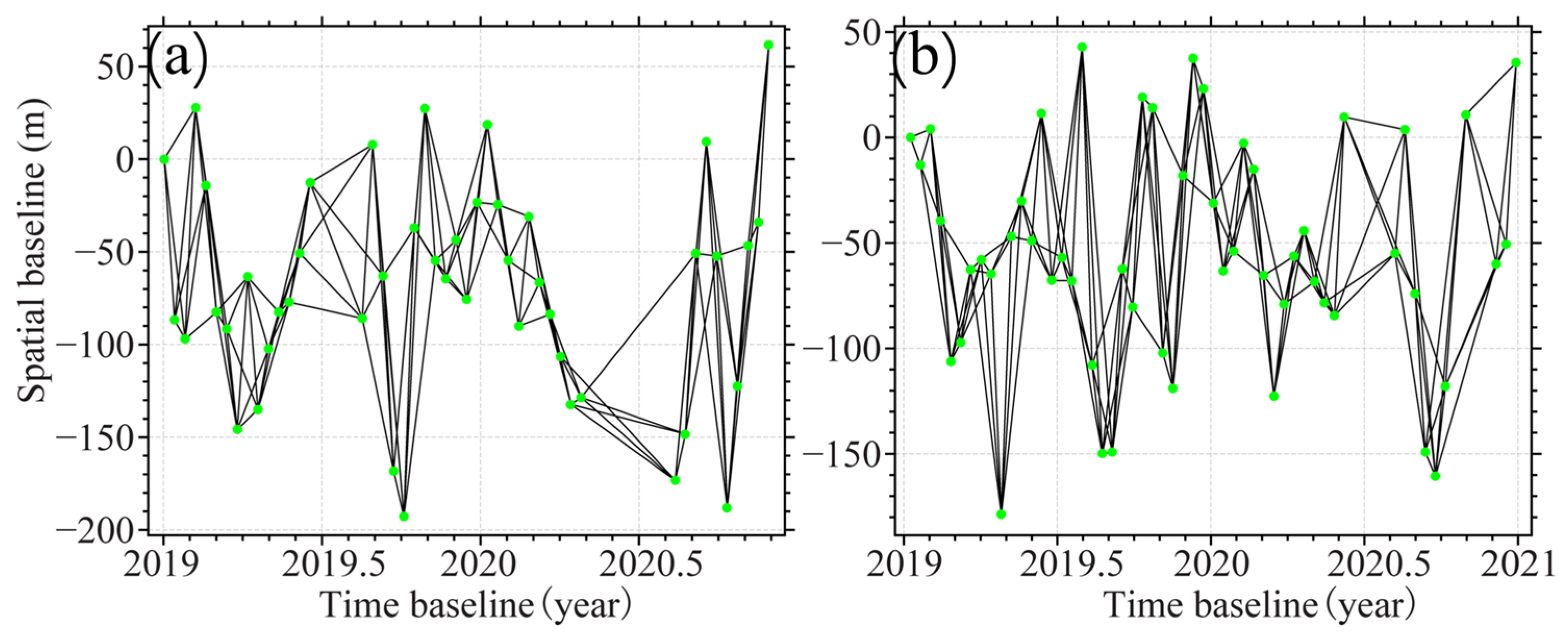

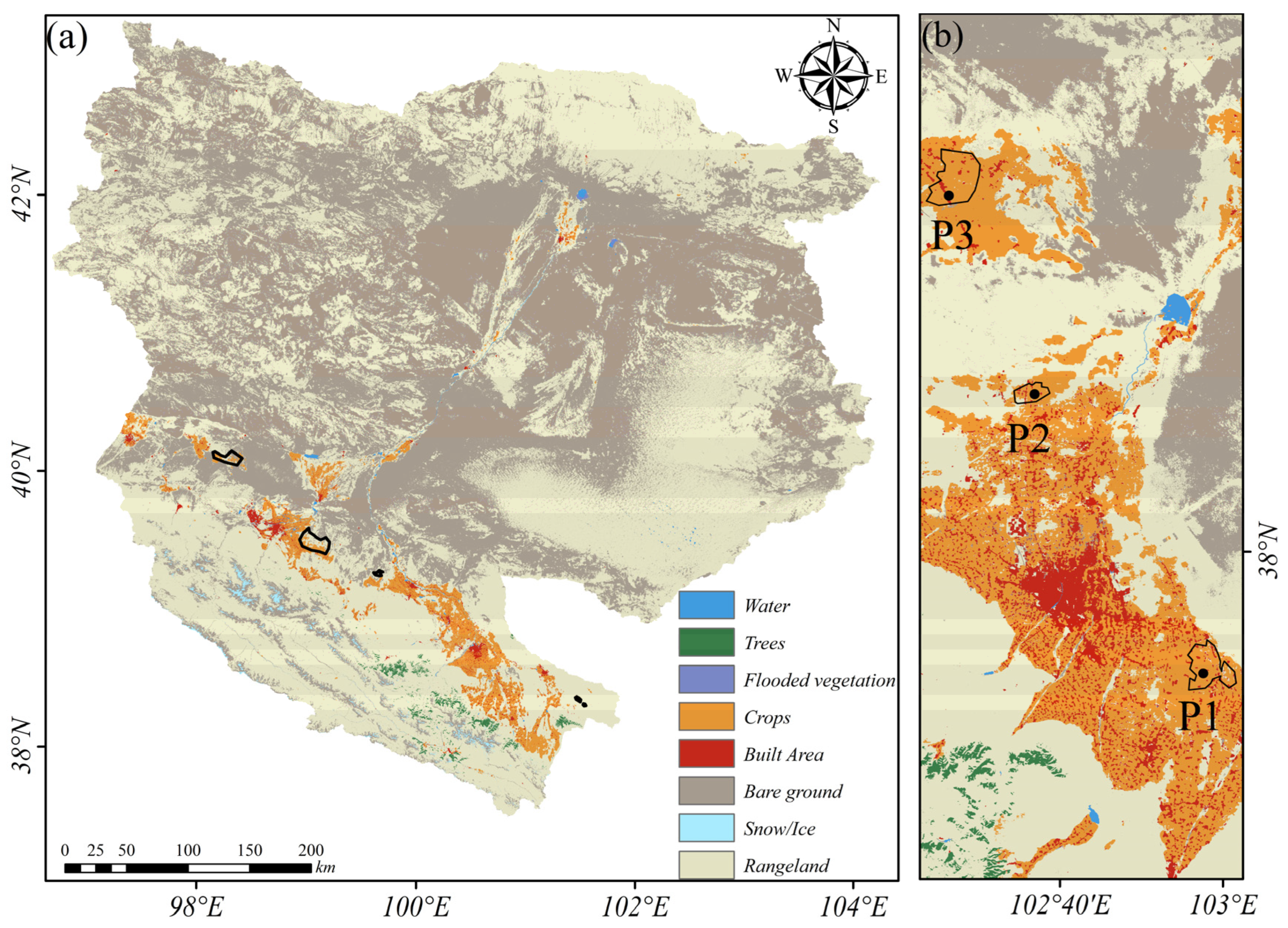

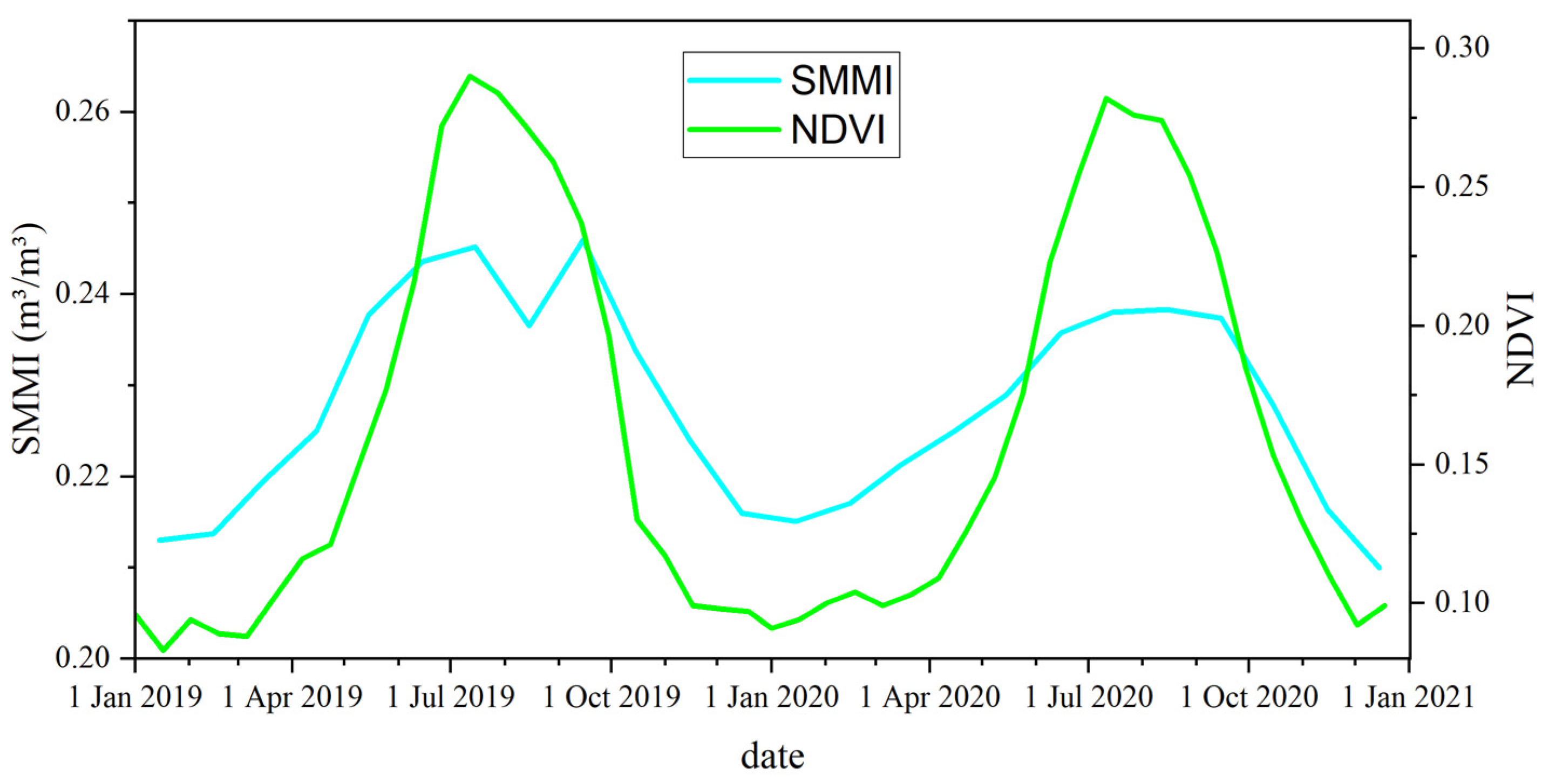

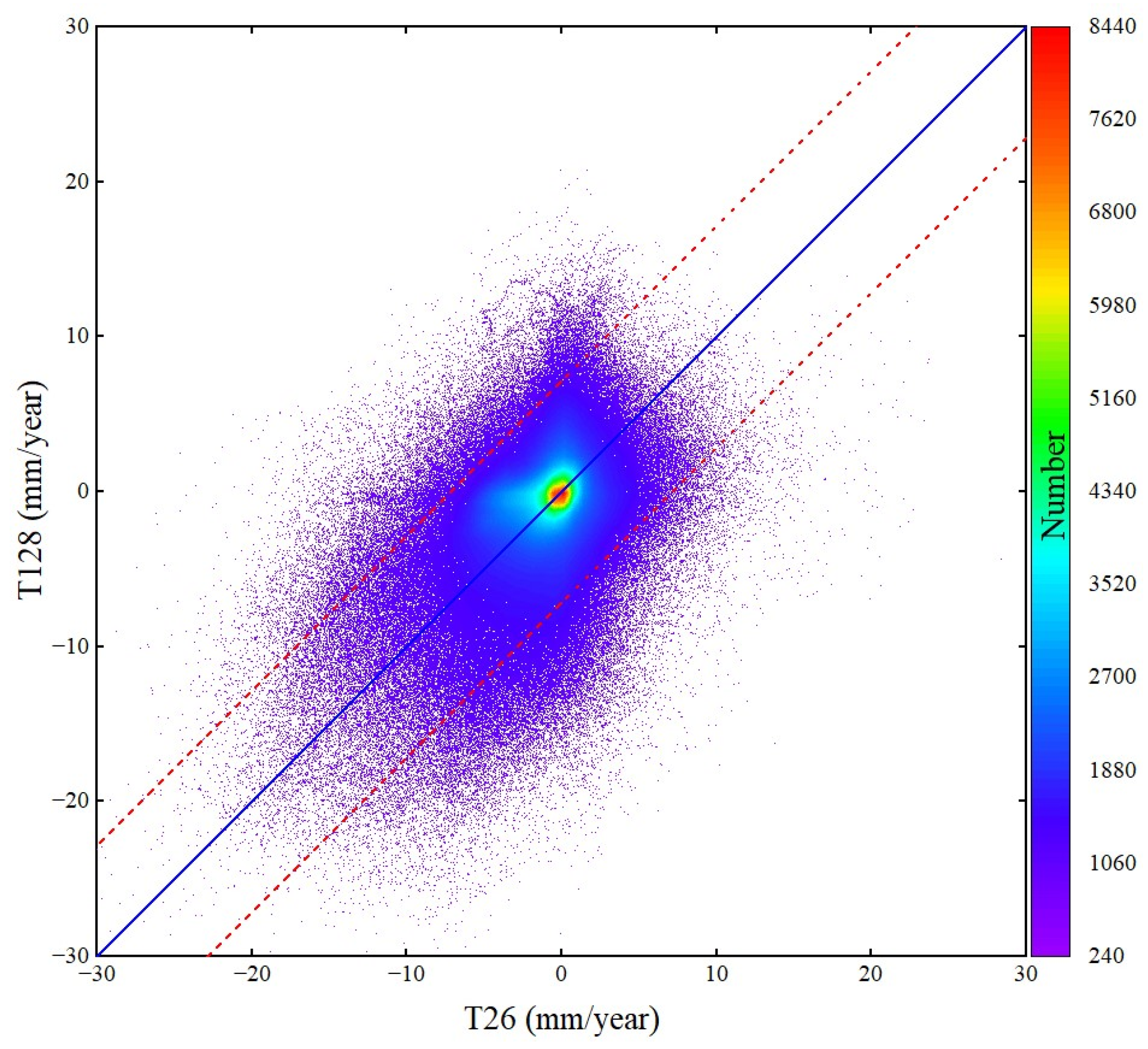


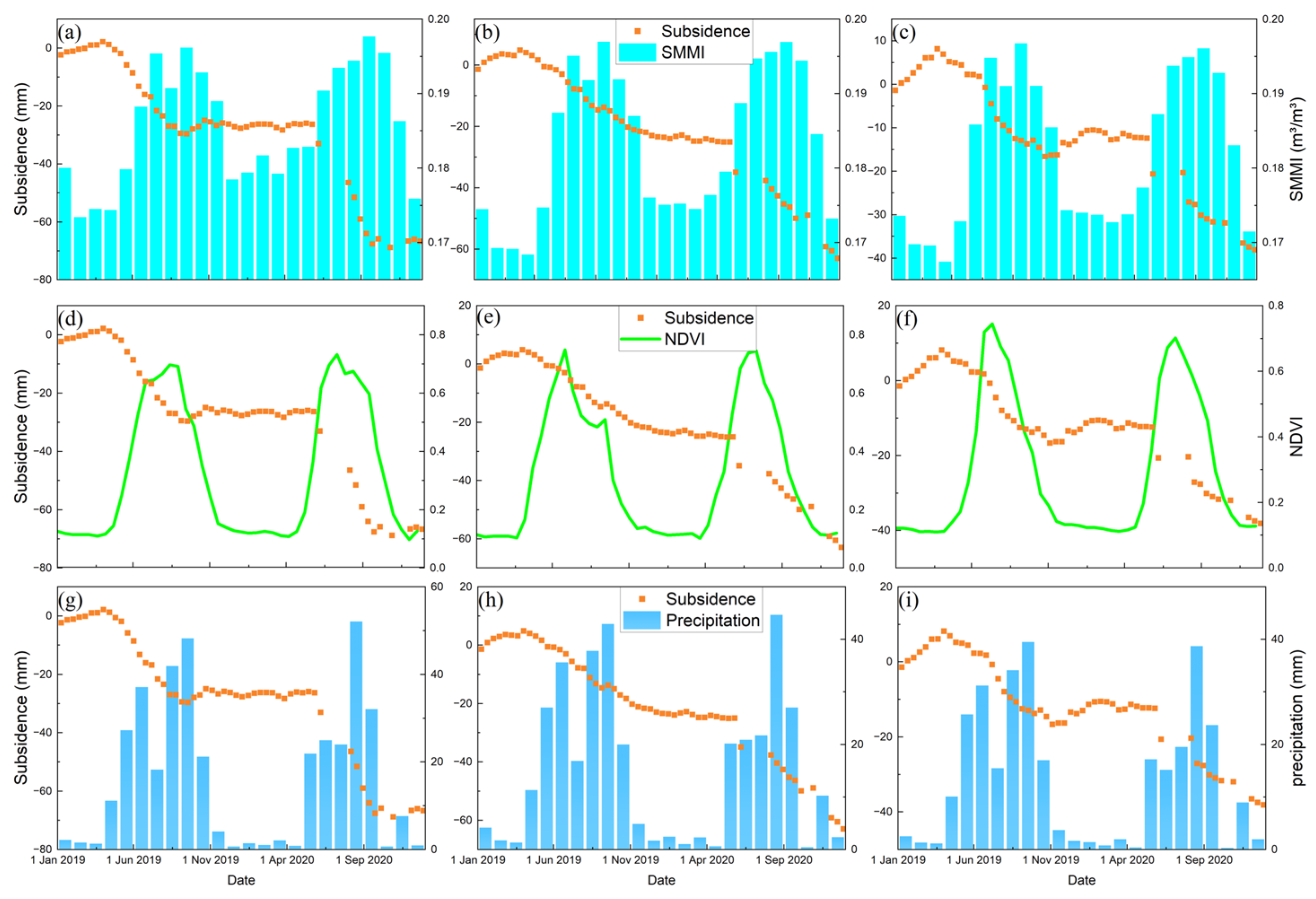
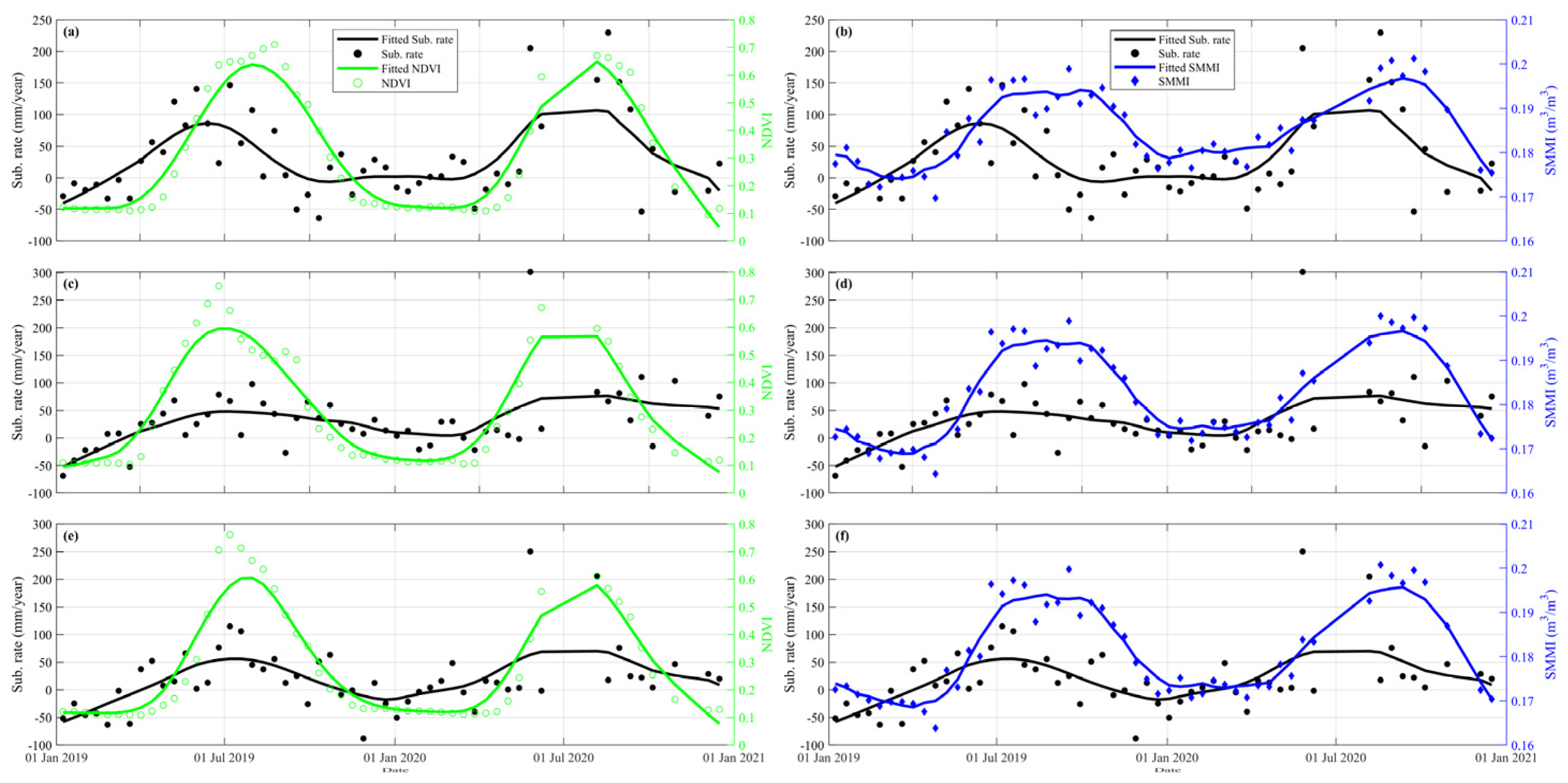
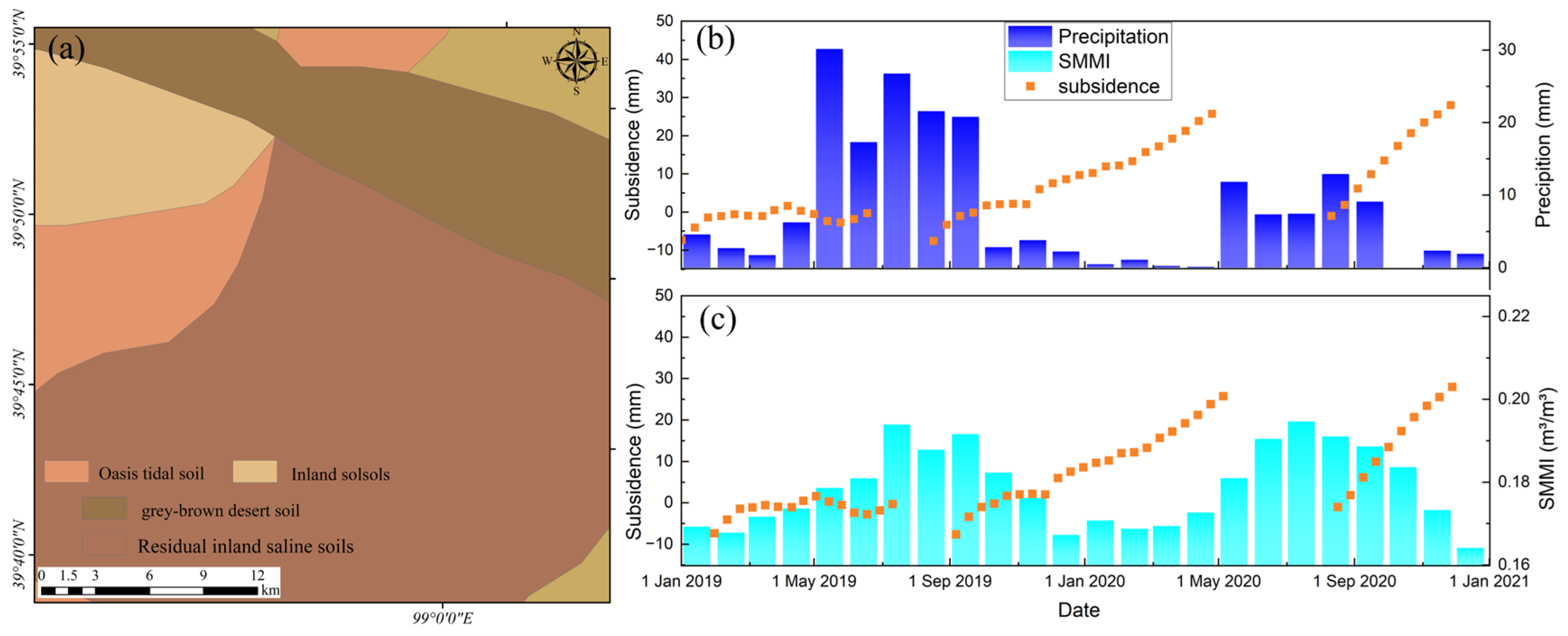
| Sensor | Sentinel-1 | |
|---|---|---|
| Track number | T26 | T128 |
| Acquisition time | 9 January 2019–29 December 2020 | 2 January 2019–28 November 2020 |
| Image number | 47 | 54 |
| Interference pairs | 135 | 156 |
| Frame number | 124, 129 | 119, 124, 129 |
| Seasonal Difference | Interannual Difference | ||||
|---|---|---|---|---|---|
| NDVI | Soil Moisture (m3/m3) | Between NDVI | Soil Moisture (m3/m3) | ||
| The overall scope of HRB | 0.19 | 0.02 | −0.01 | 0.01 | |
| Southeast of Wuwei City (p1) | 0.57 | 0.02 | 0.07 | 0.03 | |
| Southeast of Jinchang City (p2) | 0.63 | 0.05 | 0.12 | 0.04 | |
| North of Jinchang City (p3) | 0.55 | 0.03 | −0.001 | 0.03 | |
| Jinchuan Mine Park (p4) | 0.04 | 0.002 | −0.03 | −0.001 | |
| Huacaotan Coal Mine (p5) | 0.17 | 0.03 | −0.07 | 0.03 | |
| East of Suzhou District (p) | 0.08 | 0.03 | 0.0006 | 0.017 | |
| RMSE (mm/Year) | P1 | P2 | P3 |
|---|---|---|---|
| SMMI (m3/m3) | 39 | 24 | 26 |
| NDVI | 34 | 28 | 25 |
Disclaimer/Publisher’s Note: The statements, opinions and data contained in all publications are solely those of the individual author(s) and contributor(s) and not of MDPI and/or the editor(s). MDPI and/or the editor(s) disclaim responsibility for any injury to people or property resulting from any ideas, methods, instructions or products referred to in the content. |
© 2024 by the authors. Licensee MDPI, Basel, Switzerland. This article is an open access article distributed under the terms and conditions of the Creative Commons Attribution (CC BY) license (https://creativecommons.org/licenses/by/4.0/).
Share and Cite
Cui, Q.; Wang, Y.; Wang, P.; Tan, K.; Feng, G. Revealing the Ground Deformation and Its Mechanism in the Heihe River Basin by Interferometric Synthetic Aperture Radar and Optical Images. Sensors 2024, 24, 4868. https://doi.org/10.3390/s24154868
Cui Q, Wang Y, Wang P, Tan K, Feng G. Revealing the Ground Deformation and Its Mechanism in the Heihe River Basin by Interferometric Synthetic Aperture Radar and Optical Images. Sensors. 2024; 24(15):4868. https://doi.org/10.3390/s24154868
Chicago/Turabian StyleCui, Qunpeng, Yuedong Wang, Pengkun Wang, Ke Tan, and Guangcai Feng. 2024. "Revealing the Ground Deformation and Its Mechanism in the Heihe River Basin by Interferometric Synthetic Aperture Radar and Optical Images" Sensors 24, no. 15: 4868. https://doi.org/10.3390/s24154868
APA StyleCui, Q., Wang, Y., Wang, P., Tan, K., & Feng, G. (2024). Revealing the Ground Deformation and Its Mechanism in the Heihe River Basin by Interferometric Synthetic Aperture Radar and Optical Images. Sensors, 24(15), 4868. https://doi.org/10.3390/s24154868







